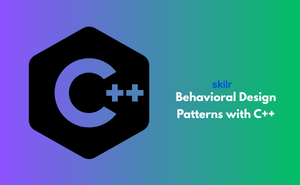👇 CELEBRATE CLOUD SECURITY DAY 👇
00
HOURS
00
MINUTES
00
SECONDS

Behavioral Design Patterns with C++
Industry-endorsed certificates to strengthen your career profile.
Start learning immediately with digital materials, no delays.
Practice until you’re fully confident, at no additional charge.
Study anytime, anywhere, on laptop, tablet, or smartphone.
Courses and practice exams developed by qualified professionals.
Support available round the clock whenever you need help.
Easy-to-follow content with practice exams and assessments.
Join a global community of professionals advancing their skills.
The demand for developers who can write optimized and maintainable code continues to grow. Understanding behavioral patterns aligns with market needs for creating scalable, efficient, and user-centric software solutions, which are critical in today's competitive landscape.
This course is ideal for software developers, computer science students, and professionals looking to improve their design skills in C++. It’s also suitable for anyone preparing for technical interviews, as questions on design patterns are frequently asked in software engineering roles.
Popular tools like Visual Studio, CMake, and CLion enhance development efficiency when working with C++. Frameworks like Qt and Boost also provide libraries that simplify the implementation of design patterns.
Absolutely. Behavioral patterns are language-agnostic concepts. While this course focuses on C++, the principles and techniques can be applied in other programming languages such as Java, Python, or C#, broadening your career opportunities.
Industries like gaming, finance, telecommunications, automotive, and aerospace heavily rely on C++ for performance-critical applications. These industries value developers skilled in design patterns for creating efficient, reusable, and scalable solutions.
Behavioral patterns standardize how objects interact and share responsibilities, improving code readability and modularity. For instance, the Observer pattern helps manage dependencies between objects, while the Strategy pattern promotes flexibility by allowing algorithm substitution at runtime.
Yes, they remain highly relevant as they address challenges in designing adaptable and maintainable systems. With C++ being widely used in game development, embedded systems, and high-performance applications, understanding these patterns equips you to work on cutting-edge projects.
Behavioral design patterns focus on communication and interaction between objects, enabling systems to achieve flexibility and scalability. In C++, these patterns allow developers to implement solutions for complex problems, like state management and event handling, using reusable and efficient designs.
Proficiency in design patterns is highly valued in software development roles. Knowledge of behavioral patterns with C++ makes you a strong candidate for positions such as software engineer, C++ developer, or system architect. These roles often require the ability to design efficient, reusable, and well-structured code.
You will learn to implement patterns like Strategy, Observer, Command, Template Method, and more. These skills will help you design robust, maintainable, and scalable applications, making you proficient in solving real-world software problems using C++.